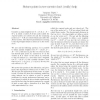Free Online Productivity Tools
i2Speak
i2Symbol
i2OCR
iTex2Img
iWeb2Print
iWeb2Shot
i2Type
iPdf2Split
iPdf2Merge
i2Bopomofo
i2Arabic
i2Style
i2Image
i2PDF
iLatex2Rtf
Sci2ools
SODA
2001
ACM
2001
ACM
Steiner points in tree metrics don't (really) help
Consider an edge-weighted tree T = (V, E, w : E R+ ), in which a subset R of the nodes (called the required nodes) are colored red and the remaining nodes in S = V \R are colored black (and called the Steiner nodes). The shortest-path distance according to the edge-weights defines a metric dT on the vertex set V . We now ask the following question: Is it possible to define another weighted tree T = (R, E , w : E R+ ), this time on just the red vertices so that the shortest-path metric dT induced by T on the vertices in R is "close" to the metric dT restricted to the red vertices? I.e., does there exist a weighted tree T = (R, E , c ) and a (small) constant such that dT (u, v) dT (u, v) dT (u, v) for any two red vertices u, v R? We answer this question in the affirmative, and give a linear time algorithm to obtain a tree T with 8. We also give two applications of this result: an upper bound, in which we show that emulating multicasts using unicasts can be almost as g...
Algorithms | Metric DT | Red Vertices | SODA 2001 | Weighted Tree |
| Added | 31 Oct 2010 |
| Updated | 31 Oct 2010 |
| Type | Conference |
| Year | 2001 |
| Where | SODA |
| Authors | Anupam Gupta |
Comments (0)

